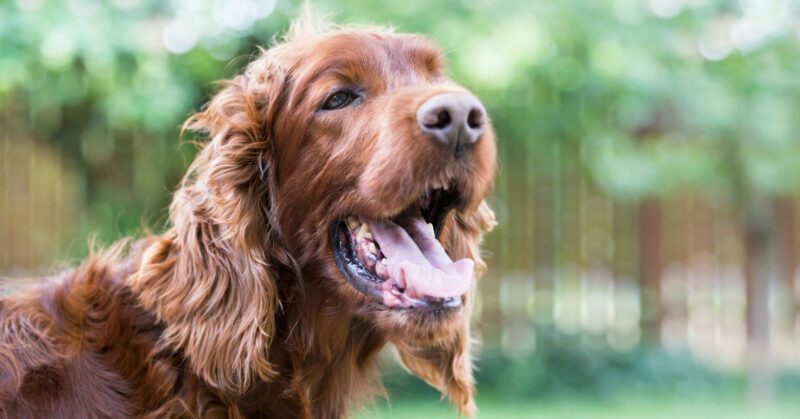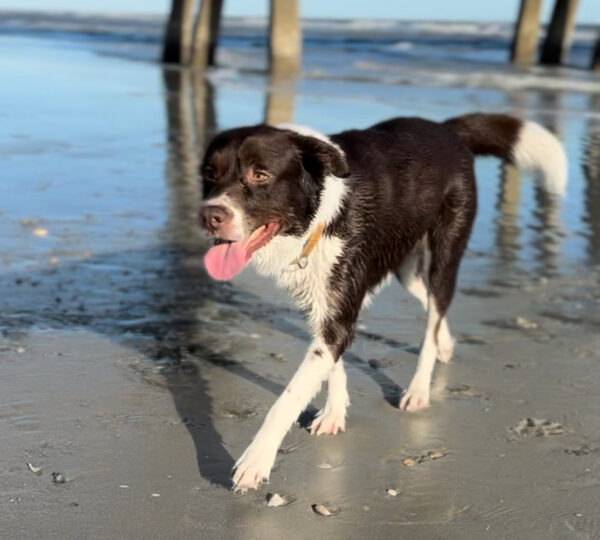
5 Reasons Why Your Dog is Panting So Much and When to Be Concerned
There’s nothing cuter than a happy, playful dog with bright eyes and a tongue hanging out. But what if your dog is panting at rest? You might be concerned there’s something wrong.
While this article is not intended to diagnose or treat causes of panting in dogs, understanding the common reasons behind it can help get your dog the care they need.
What Happens When a Dog Pants
Dogs pant to cool themselves off, much like humans sweat when they’re exercising or outside in the summer heat.
If your dog has been running around or playing a lot, or if it’s warm, your dog will naturally pant to maintain a normal body temperature. The moisture on their tongue absorbs their internal heat and then is evaporated into the air.
But how can you tell if your dog is panting too much?
Pin Me Now, Read Me Later!

What’s a Normal Dog Respiratory Rate?
According to one veterinary site, a normal respiratory rate for a dog is between 10-40 breaths per minute. You can measure this by counting the number of breaths they take during the course of one minute. It might be helpful to place your hand very gently on their stomach.
It’s a good idea to establish your dog’s baseline respiratory rate when they’re at rest, so you can more readily identify when something isn’t right.
If your dog is resting and it’s not warm out, and their respiratory rate is faster than normal, you should consult a veterinarian. They’ll perform diagnostic tests that will help them understand the cause of your dog’s panting.
5 Common Reasons Why Dogs Pant a Lot
The causes of your dog’s panting are pretty varied. Some are totally normal and some signal that your dog needs medical attention.
Reason #1: They’ve been playing and/or running.
It’s normal for your dog to pant when they’re running around and playing. It’s their body’s natural way of cooling them down, much like how humans sweat when they’re exerting themselves.

Reason #2: They’re anxious
Anxiety affects as many as 40% of dogs. Noise anxiety is the most common, followed by separation anxiety.
If you see your dog pant during a thunderstorm or when you are getting ready to leave the house, anxiety may be to blame.
You can learn about my dog, Chilly’s, experience with noise anxiety in this article. And you can read about how we managed Buck’s separation anxiety here.

And for a more comprehensive look at anxiety in dogs, you can visit my Pet Anxiety Awareness page, which covers all the symptoms of anxiety and how to get help for your dog.
Reason #3: Outside temperature
Even if your dog isn’t running around or playing, if it’s very hot outside your dog may pant a lot. This can be normal, but it’s also important to note when the heat causes your dog distress, as they may be in heatstroke.
This can be even more common among snub nosed dogs, like Boston terriers, pugs, or bulldogs.
Lisa’s French bulldog, Max became overheated after a long walk in the Parisian summer heat. The symptoms came on rather suddenly, and Max became very lethargic and then began vomiting.

She was able to cool him down safely, but it was a lesson learned to always take it easy in the summer and make sure Max has access to a cool area.
If you think your dog has heatstroke, it’s important to call your veterinarian right away, as it can become deadly. They may tell you to cool your dog down slowly, using cool wet towels, or other methods.
Reason #4: Excitement
Temporary panting is common when dogs are excited, as their metabolism speeds up.
Zuzu, a Yorkie terrier mix, gets excited about boat rides and can often be seen with her tongue out as she speeds across the lake.

Reason #5: Disease or Distress
If your dog isn’t anxious, playing hard, excited, or hot, there could be underlying health issues causing your dog to pant. These may include:
- Cushing’s disease
- Respiratory issues, like infections or asthma
- Pain (from anywhere in the body)
- Medication
- Parasites
- Hernia
- Anemia
- Any other medical issue causing your dog distress
If your dog has started panting abnormally, it’s important to call your veterinarian right away to rule out any serious medical conditions.
Why Do Older Dogs Pant a Lot?
As your dog ages, it becomes less likely that their panting is due to increased activity.
A dog is considered senior when they reach seven years of age. So towards the younger end of the scale, they still are likely quite active and could pant a lot due to exertion.
However, for an older dog that’s not active, panting may be a sign of distress or pain. Some common reasons are:
- Pain, such as from osteoarthritis
- Anxiety, possibly as a result of “old dog syndrome”
- Disease, including those listed previously
If your senior dog is panting a lot, it’s important to see a veterinarian to rule out acute conditions. If chronic conditions are causing them distress, you’ll want to discuss how to manage them with your veterinarian.
Various medications are available to help keep your beloved senior dog comfortable in their golden years.
Why Your Dog Pants a Lot at Night
Your dog may be panting at night for very normal and fixable reasons, including:
- The room is too hot
- They are thirsty and don’t have access to water
- They’re anxious at night (more common than you think!)
- They have allergies (and blocked airways as a result)
However, again, it’s important to visit your veterinarian to rule out anything serious.
How to Calm a Panting Dog
If your dog is panting because they’re anxious, it’s important to calm them as much as possible.
As I mentioned, I know about canine anxiety all to well, as I had first-hand experience with my dog Buck, who suffered from debilitating separation anxiety.

The way to bring your dog relief from anxiety and minimize or eliminate symptoms, like panting, will depend on the type of anxiety they have.
For separation anxiety, there are medications available, like Reconcile® that can help. This is what we used with Buck, in conjunction with specific training techniques that were recommended to us by a veterinary behaviorist. You can learn more about how to manage your dog’s separation anxiety in this guide I created.
My dog Chilly suffered with terrible noise anxiety, the most common kind of anxiety in dogs. Behavior modification (training) can help, but severe cases may need to combine these techniques with medication, like what we used for Chilly.

Other types of anxiety includes travel anxiety, vet visit anxiety, grooming anxiety, and anxiety over meeting new people or animals (reactivity).
For a more comprehensive look at how to manage your dog’s anxiety, you can check out my dog anxiety resources here.
When to See Your Veterinarian About Your Dog’s Panting
If your dog is panting and their environment is not hot and they haven’t been exerting themselves, it’s important to visit your veterinarian right away to rule out anything serious.
If your dog has been exerting themselves and/or it’s hot outside, you should monitor your dog for signs of heatstroke and call your veterinarian immediately to get instructions on how to cool them down safely.
The Final Woof
If your dog is panting, it’s important to rule out any serious causes, which may include pain, disease, or distress.
For most healthy dogs, panting is a natural way of cooling off the body.
If you’re ever in doubt, it’s always best to visit your veterinarian. They have training needed to provide the best care for your dog.







Comments (0)